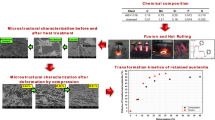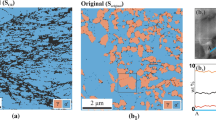Conclusions
-
1.
An investigation of the plasticity of austenitic alloys N22G2. 5 and 115G4 by measuring their linear extension has established a sharp increase in plasticity during the process of isothermal martensitic transformation. Hence, during transformation at-196° C, a definite plastic deformation (about 0.2%) is observed at tensile stresses (nominal transformation yield stresses σ ′s ) of 3. 1 kg/sq. mm in alloy 115G4 and 5. 6 kg/sq. mm in alloy N22G2. 5, whereas the yield stress σs of the latter alloy, when the proper quantity of martensite is present in the structure is 76 kg/sq. mm, this exceeding the transformation yield stress σ ′s by a factor of 13.5.
-
2.
A proportionality between the rate of martensitic transformation and the increase in plasticity during the transformation process has been established. The increase or decrease of transformation rate of the alloy alters correspondingly the rate of plastic extension. The change in the degree of transformation similarly affects the total plastic extension at equal tensile stresses. The most pronounced increase of plasticity during transformation (in various alloys) occurs with the highest transformation rate at identical degrees of transformation and tensile stresses, irrespective of the strength properties of the alloys in the initial condition.
-
3.
On the basis of the example of the austenitic alloy N22G2.5, it was shown that when the martensitic transformation occurs under tension (5–13.9 kg/sq. mm) the second-order distortions which arise in austenite are removed as a result of the austenite-martensite transformation. This is accompanied by a continuous refinement of the sub-grains.
-
4.
Data have been obtained showing an anomalous decrease of the resistance to plastic deformation during a reversion of the martensitic transformation, an effect earlier observed in the direct martensitic changes.
Similar content being viewed by others
References
N. E. Karskii and T. I. Sobelev,Zavod. Lab., vol. 15, 1949, No. 11, pp 1355–58.
V. G. Vorob'ev,Metallov. Obra. Met., 1958, No. 3, pp 35–8. [Brutcher Translation No. 4175].
M. E. Blanter and A. K. Mashkov, ibid., 1959, No. 1, pp 6–10. [HB#4474].
E. Hornbogen and G. Wassermann,Z. Metallk., vol. 47, 1956, No. 6, pp 427–33.
P. Ya. Kayushnikov, Coll. Progressive Plant Experience, Hot Working of Metals, 1956.
V. N. Revinov, Coll. Papers of KhAI, 1957, No. 17.
V. N. Krivobok and C. R. Mayne,Metalw. Prod., vol. 99, 1955, No. 52,
N. N. Lyulicheva and N. V. Pisareva,Metallov. Term. Obra. Met., 1959, No. 4, pp 19–22. [HB Translation 4567].
G. V. Kurdyumov and L. G. Khandros,Zhur. Tekh. Fiz., vol. 9, 1949, pp 761–8. [See also Brutcher Translation No. 2393].
Ya. M. Golovchiner, Problems of Metal Science and Metal Physics, 1951.
Author information
Authors and Affiliations
Rights and permissions
About this article
Cite this article
Blanter, M.E., Mashkov, A.K. Changes in strength and plasticity during direct and reverse martensitic transformations. Met Sci Heat Treat 1, 15–20 (1959). https://doi.org/10.1007/BF00814275
Issue Date:
DOI: https://doi.org/10.1007/BF00814275




